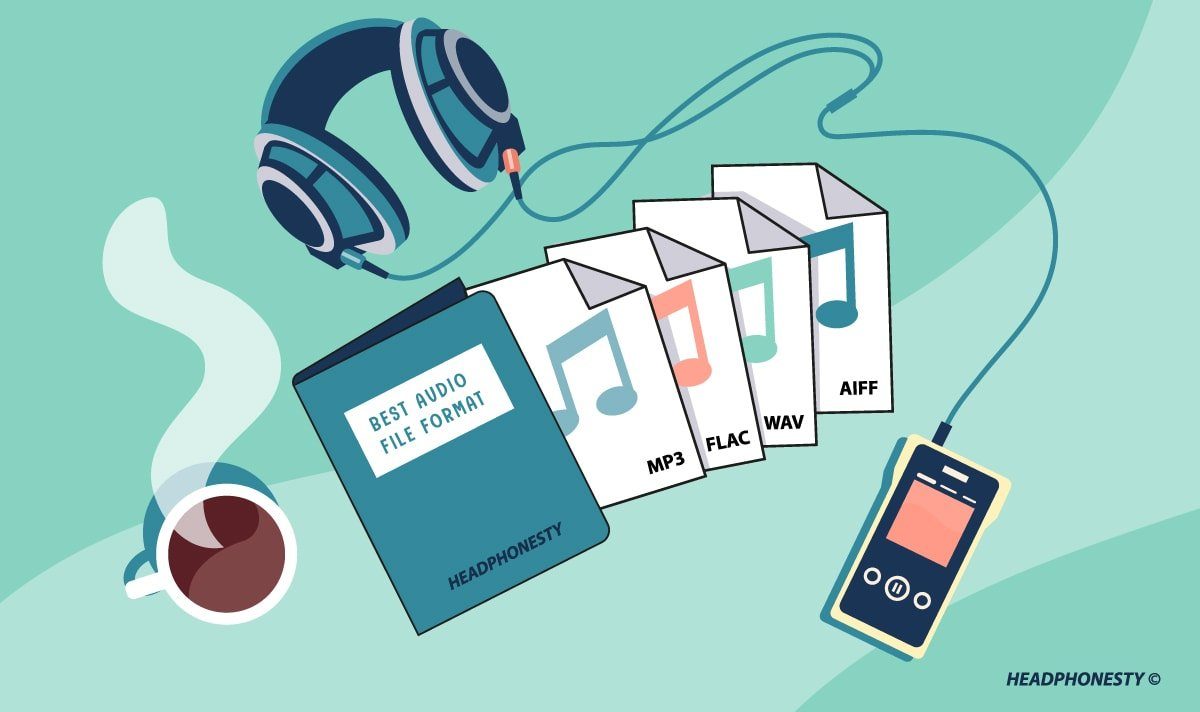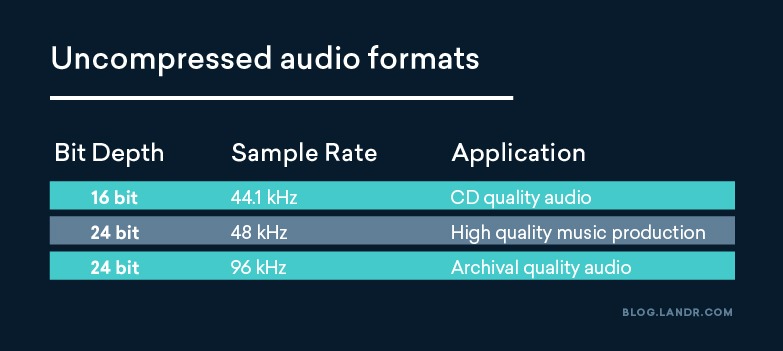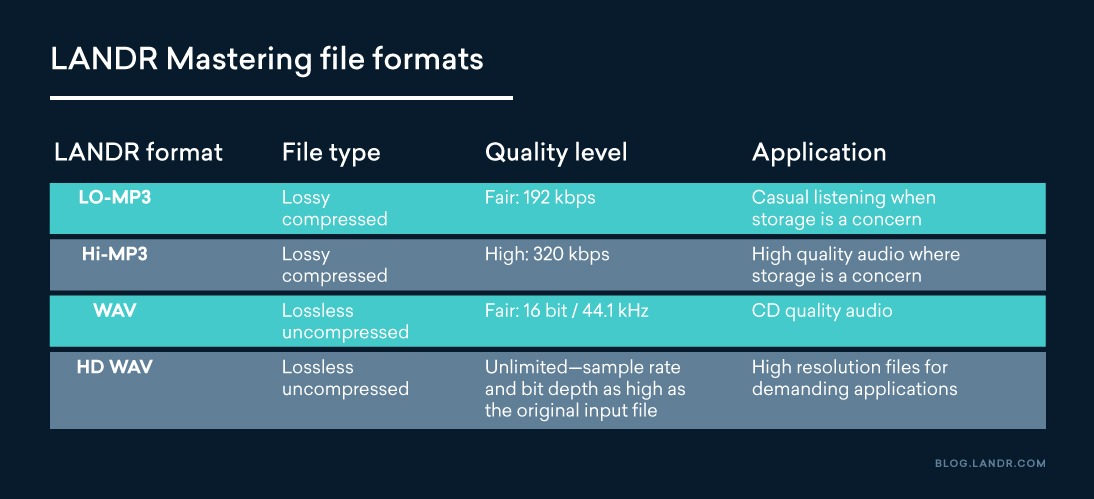Digital audio files are the raw material of music production.
From streaming platforms to sample packs, all the audio you work with needs to be stored somewhere in a file.
However many kinds of audio formats are effective in different situations.
How do you know which audio file kind to use and get the most effective results?
In this article, we’ll explain everything you need to learn about audio file formats and how to choose the right one for the job.
Let’s start!
What are audio file formats?
Audio file formats are digital requirements for storing audio information.
The raw data in a stream of audio from the analog-to-digital converter in your audio interface is encoded using PCM or pulse code modulation technique.
You should organize the PCM audio into a file so you’ll be able to work with it or play it back in a system.
Different audio file formats use different containers and varying strategies of data compression to organize the PCM stream.
Relying on which you choose, each format represents the same information in several storage sizes or quality levels.
Along with that, some audio file formats carry metadata that provides information about the file or its content.
Lossless vs. lossy audio files
There are two main kinds of audio files—lossless file formats, and lossy file formats.
The difference between the two has to do with data compression.
Data compression means making the files take up less space on a hard drive. It’s not the same as the dynamic range compression utilized in music production.
Some strategies of data compression make the file smaller but still preserve 100% of the information in the raw audio stream.
Other compression types that work by eliminating data in the audio that doesn’t make a big effect on the sound are lossy compressed formats.
Uncompressed audio formats
There are different audio file formats without any data compression. These are uncompressed audio formats.
These file kinds work as a container for raw audio data without reducing its size or quality in any way.
These are the largest files to work with, however, they provide the best level of detail in the audio information.
Uncompressed audio files are the kind most often used for recording and mixing music in a DAW.
Even so, uncompressed audio files also come in several quality levels. These rely on the accuracy and precision with which the analog audio signal was converted to digital.
The better the use the sample rate and bit depth, the more information they can capture in the conversion process.
Bit depth represents the precision of the AD/DA converter for measuring amplitude or the volume level of the signal.
You can think of it as the variety of tick marks on a ruler—the more closely spaced they are, the less often the measurement will fall in between the two marks.
Sample rate shows the number of times the measurement is taken in a second. A higher sample rate means more individual measurements are made.
Here is a list of frequent quality levels for uncompressed audio:
Audio bitrate
Lossy compressed audio files may be encoded at different quality levels.
They use the bitrate or the amount of data encoded per second as a standard to rate the quality of this file format.
At lower bitrate settings, the compressed files will be much smaller, however, it may sound worse.
In the past, this was crucial since storage media had limited capacity and networks couldn’t easily transmit massive files.
However, storage and bandwidth aren’t so much of a concern in today’s digital world.
That’s why a larger file with a better bitrate is almost always your best option when you need to use a lossy format.
A high-quality standard for MP3 compression is 320 kbps. In these settings, it’s very difficult to distinguish compressed audio from uncompressed in casual listening tests.
The 6 most common audio file formats
There are lots of different file formats out there, but not all of them are popular.
In fact, there is only a handful that you’ll commonly see in the wild. Here are the main ones to know:
MP3
MP3s are the most typical file kind for general listening.
The use of MP3s exploded during the file-sharing revolution of the early 2000s. The reason why has to do with the sound quality they were able to achieve in such a small package.
MP3s were the very first audio file format that made music simple to send back and forth across the internet in listenable audio quality.
They were also simple to encode from tracks on a CD, which led to the proliferation of illegal music downloads.
MP3 files are still very common today and a few digital download stores like Bandcamp promote them as their primary format.
AAC
AAC is a lossy compressed type designed by a group of digital technology companies including Dolby, Microsoft, and Bell. It was intended as an extra efficient successor to MP3. AAC is famous for being the standard format for Apple devices like the iPod.
If you ever purchased music on the iTunes store or used iTunes to rip CDs to your library, you might need some AAC files lying around.
Ogg Vorbis
Ogg Vorbis is an open-source alternative to lossy compressed formats like MP3. It’s notable for being the file kind used for audio material on Wikipedia.
Regardless of its widespread use, MP3 is a proprietary format. In response, the open-source community made Ogg Vorbis an alternative that’s free and editable.
FLAC
FLAC is an open-source lossless compressed file format. It was one of the first lossless compressed formats to achieve popularity.
FLAC files make listening to lossless audio available on devices with limited storage. The advantages of lossless audio as a listening medium are often from audiophiles, however, see for yourself if you want them!
WAV/AIFF
These are the most typical file types for working with lossless uncompressed audio.
Since there isn’t a change to the amount of information included, both file types have similar performance.
WAV is available for use on PC, while AIFF is for the Macintosh. Both formats are compatible on either platform.
How to choose an audio file format
With the background info out of the way, here are the easy guidelines for selecting an audio file format for:
- Music production, use uncompressed audio with a high sample rate and bit depth (24 bit / 48 kHz WAV or AIFF)
- General listening, select a high bitrate compressed format (320 kbps MP3, AAC, or similar)
- Critical listening, select a lossless compressed format (FLAC)
LANDR Mastering file formats
LANDR Mastering provides downloads in four different quality tiers—LO-MP3, Hi-MP3, WAV, and HD WAV.
Here’s a breakdown of each one:
Hot tip: No process in music production can add audio quality back if it didn’t exist already. To get the highest quality file from LANDR Mastering, it’s essential to start with a high-resolution file. We recommend setting your DAW sessions to at least 24 bit / 44.1 kHz, or higher if possible.
File system
Audio file formats are a technical detail in digital audio that will not seem essential.
However, choosing the right one can make a difference to your final product.
If you’ve made it through this article you’ll have an excellent starting for understanding audio file formats.



